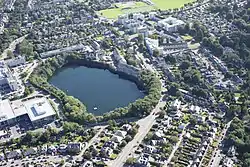Rubislaw quarry
Rubislaw Quarry is a quarry situated at the Hill of Rubislaw in the west end of the Scottish city of Aberdeen. At 142m deep with a diameter of 120m, Rubislaw Quarry is one of the biggest man-made holes in continental Europe. Since its closure in 1971, it has filled with water.[1] It has never been marketed as a tourist attraction and is currently inaccessible, hidden by trees and surrounded by flats and office buildings.

John Smith and Archibald Simpson were architects who constructed some of Aberdeen's best known buildings from granite in the early 19th century. Waterloo Bridge in London, the terrace of the Sphinx and the Forth Bridge were also constructed with granite from Aberdeen. Matthew Forster Heddle found the quarry a good source for the minerals tourmaline and beryl. The fine grey granite from the quarry is visible in the majority of Aberdeen's buildings.
History
Rubislaw quarry was opened in 1740. In 1778/9, Aberdeen City Council sold it to a businessman for £13, as it was not thought to be a source of good building material. However, over the next 200 years, an estimated six million tonnes of granite were excavated from the quarry, giving Aberdeen the name of 'The Granite City'. The quarry closed in 1971.
In 2010 the quarry was acquired by former oil consultant Sandy Whyte and Hugh Black, the former managing director of a construction company.[2] The sale price is believed to have been £60,000.[3]
References
- "Biggest man-made hole in Europe goes on sale". STV. 21 January 2010. Archived from the original on 27 October 2013. Retrieved 27 October 2013.
- BBC 9 June 2010 - Famous Aberdeen granite quarry sold
- "Peter Ross: Who would pay £60,000 for a 450 foot hole in the ground?". Retrieved 16 March 2018.
